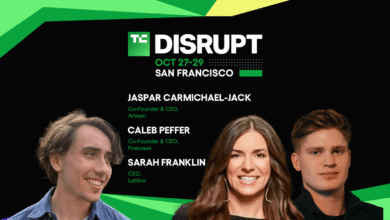Hance demos tiny AI audio software at TechCrunch Disrupt 2025

▼ Summary
– Hance is a Norwegian startup developing compact, fast audio processing software to solve communication issues in high-noise environments like Formula One racing.
– The company was founded by audio industry experts and trained its AI models using high-quality recordings from various sources including Formula One cars and volcanoes.
– Hance’s models are only 242 kB in size, enabling real-time on-device processing with minimal latency for noise reduction and speech enhancement.
– The technology has attracted major clients including Intel, Riedel Communications, and is being explored for law enforcement and defense applications.
– Hance will showcase at TechCrunch Disrupt 2025 and plans to maintain its competitive edge through continued rapid development and R&D focus.
Picture a Formula One driver speeding around a track at 200 miles per hour. Suddenly, a crucial radio message from the engineer crackles through, but the words are lost in a storm of noise. There’s no time to ask for a repeat; the race, and safety, hang in the balance. This is exactly the kind of high-stakes communication challenge that Norwegian startup Hance aims to solve with its remarkably compact and swift audio processing software. Already winning clients like Intel and Riedel Communications, the official radio partner of F1, Hance will showcase its technology among 200 selected startups at TechCrunch Disrupt 2025, held from October 27 to 29 at San Francisco’s Moscone Center.
The small team of about ten brings deep audio industry expertise. Co-founder Stian Aagedal also serves as CEO of audio editing firm Acon Digital, while Peder Jørgensen operates the sound effects library Soundly. Recognizing the potential of artificial intelligence to transform audio workflows, especially in noise reduction and isolation, the Hance team began training proprietary models several years ago. They used Soundly’s extensive collection of high-quality recordings, capturing everything from the thunder of F1 engines to the explosive sounds of Icelandic volcanoes.
A major breakthrough came when they compressed the Hance processing models down to a mere 242 kB. This tiny footprint allows the software to run directly on devices rather than relying on cloud computing, slashing both latency and energy use. Hance claims its models can isolate sounds, strip away noise, echo, and reverb, and improve speech clarity, all with a latency of just 10 milliseconds.
Although several firms provide comparable audio enhancement tools, Hance sets itself apart with models that are both minuscule and energy-efficient, enabling real-time processing on hardware of any scale. This capability makes the software ideal for Riedel’s communication systems used in F1 and FIFA events, and also appealing for law enforcement and defense applications, according to CEO Joote Hika.
Hika sees even broader horizons for Hance now that Intel has come on board as a partner. The startup has collaborated with the chip giant to optimize its models for various Intel processors, including the latest neural processing units. Hance is also in discussions with other semiconductor manufacturers and a smartphone maker whose identity remains confidential.
These professional alliances are non-exclusive and expected to span several years, which supports Hance’s scalability. Still, Hika acknowledges the need for rapid, continuous innovation to maintain a competitive edge. The company recently hired its first chief commercial officer but intends to keep its primary focus on research and development. Hika emphasized a preference for hiring “AI-capable” personnel to keep the organization agile and forward-thinking.
“We’ve built a lead over our rivals, but we must sustain that momentum. We’re moving quickly to stay ahead,” Hika stated.
For those interested in learning more about Hance and other emerging startups, TechCrunch Disrupt 2025 offers a platform to hear pitches, attend sessions, and connect with industry leaders. The event runs from October 27 through 29 in San Francisco.
(Source: TechCrunch)





